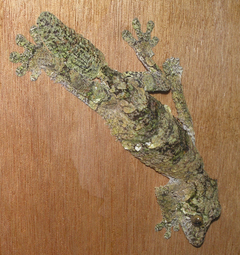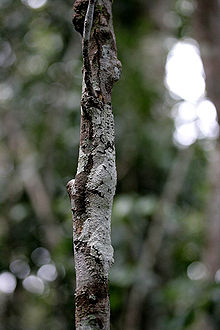- Uroplatus sikorae
-
Mossy leaf-tailed gecko 
Uroplatus sikorae Conservation status Scientific classification Kingdom: Animalia Phylum: Chordata Class: Reptilia Order: Squamata Family: Gekkonidae Subfamily: Gekkoninae Genus: Uroplatus Species: U. sikorae Binomial name Uroplatus sikorae
Boettger, 1913Uroplatus sikorae is a species of gecko commonly referred to as the Mossy leaf-tailed gecko. This species, endemic to Madagascar, is found in primary and secondary forests on the island. It has the ability to change its skin color to match its surroundings and possesses dermal flaps which break up its outline when at rest.
It is a CITES II protected animal due to habitat loss and overcollection for the pet trade.
Contents
Taxonomy and etymology
The generic name, Uroplatus, is a Latinization of two Greek words: "ourá" (οὐρά) meaning "tail" and "platys" (πλατύς) meaning "flat". Its specific name is a Latinization of the name Franz Sikora, a German fossil-hunter and explorer of Madagascar. The species was first described by German zoologist Oskar Boettger but not published until three years after his death.[1] Its common name refers to the mossy-like camouflage patterns and colors of the lizard's skin.
The genus Uroplatus contains 12 species endemic to Madagascar; Uroplatus sikorae is the only species within this genus containing a subspecies: Sameit's Leaf-tailed gecko Uroplatus sikorae sameiti, named for Joachim Sameit.[2] This subspecies was identified in 1990, the chief identifier is the inside of its mouth is pink as opposed to the black coloration of the parent species.[2]
Phylogenically it has been placed within a monophyletic complex consisting of three other species of Uroplatus: U. fimbriatus, U. giganteus, U. henkeli.[3] This complex represents the larger species of the genus.[3]
Description
Mossy leaf-tailed geckos are nocturnal and arboreal. Their eyes are large, lidless, and have yellow sclera with elliptical pupils, suited for the gecko's nocturnal habits. The mossy leaf-tailed gecko ranges in size from 6 to 8 inches (15 to 20 cm) when measured from nose to base of the tail. They spend most of the daylight hours hanging vertically on tree trunks, head down, resting. During the night, they will venture from their daylight resting spots, and go off in search of prey.[4]
As with all Uroplatus geckos, the tail is flattened and leaf-like. U. sikorae has coloration developed as camouflage, most being grayish brown to black or greenish brown with various markings meant to resemble tree bark; down to the lichens and moss found on the bark. U. sikorae has flaps of skin, running the length of its body, head and limbs, known as the dermal flap, which it can lay against the tree during the day, scattering shadows, and making its outline practically invisible.[4] Additionally, the gecko can change its skin color to match its background similar to the chameleons of Madagascar.[5]
Diet
Mossy leaf-tailed geckos are insectivores eating insects, arthropods, and gastropods.
Distribution and habitat
Uroplatus sikorae are endemic to Madagascar and are found nowhere else.[6] These geckos are an arboreal species relying on their natural camouflage as they dwell among the trees of the Eastern and central tropical forests of Madagascar.[6]
Captivity
The mossy leaf-tailed gecko is uncommon in captivity and often kept in breeding pairs or trios. They eat a variety of appropriately sized insects including crickets and moths. If breeding is successful in captivity, eggs will be laid every 30 days and take 90 days to hatch.
Threats
Habitat destruction and deforestation in Madagascar is the primary threat to this animal's future as well as collection for the pet trade.[7] The World Wide Fund for Nature (WWF) lists all of the Uroplatus species on their "Top ten most wanted species list" of animals threatened by illegal wildlife trade, because of it "being captured and sold at alarming rates for the international pet trade". It is a CITES Appendix 2 protected animal.[7]
References
- ^ Boettger, O. (1913). Reptilien und Amphibien von Madagascar, den Inseln und dem Festland Ostafrikas. Pp. 269–375. In: Voeltzkow, A. Reise in Ostafrika in den Jahren 1903–1905. Wissenschaftliche Ergebnisse. Vol. 3. Systematische Arbeiten. Schweizerbart sche Verlagsbuchhandlung, Nägele und Sproesser, Stuttgart
- ^ a b Böhme, W., and P. Ibisch. (1990). Studien an Uroplatus. l. Der Uroplatus fimbriatus-Komplex. Salamandra 26:246–259
- ^ a b Greenbaum, Eli; Bauer, Jackman, Vences, Glaw (2007). "A phylogeny of the enigmatic Madagascan geckos of the genus Uroplatus". Zootaxa (Magnolia) 1493: 41–51.
- ^ a b Pianka, Eric R. (2006). Lizards: Windows to the Evolution of Diversity. Berkeley: University of California Press. pp. 247. ISBN 0-520-24847-3.
- ^ Selim, Jocelyn (31 March 2005). "A Naturalist's Paradise". Discover Magazine. http://discovermagazine.com/2005/mar/naturalists-paradise. Retrieved 31 October 2008.
- ^ a b Bradt, Hilary; Nick Garbutt, Derek Schuurman (2001). Madagascar Wildlife: A Visitor's Guide. Bradt Travel Guides. pp. 144. ISBN 1841620297.
- ^ a b "Inclusion of Uroplatus spp. in Appendix II" (pdf). Technical comments in support of amendments to CITES appendices submitted by Madagascar. CITES. 2004. http://www.cites.org/common/cop/13/inf/E13i-32.pdf. Retrieved 02 November 2008.
Categories:- IUCN Red List vulnerable species
- Flat-tailed geckos
- Endemic fauna of Madagascar
- Reptiles of Africa
- Reptiles of New Caledonia
- Gekkonidae
Wikimedia Foundation. 2010.



